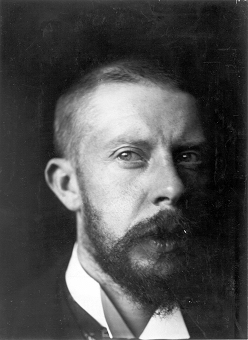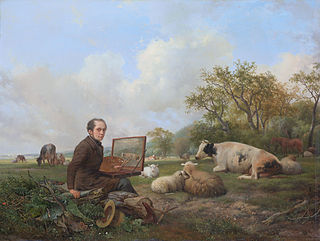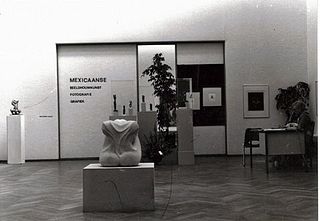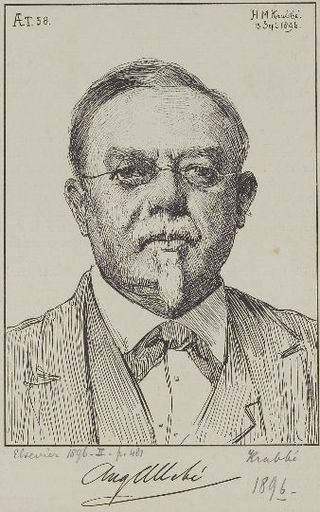This is an alphabetical index of articles related to painting.

Vincent Willem van Gogh was a Dutch Post-Impressionist painter who is among the most famous and influential figures in the history of Western art. In just over a decade he created approximately 2100 artworks, including around 860 oil paintings, most of them in the last two years of his life. They include landscapes, still lifes, portraits and self-portraits, and are characterised by bold, symbolic colours, and dramatic, impulsive and highly expressive brushwork that contributed to the foundations of modern art. Only one of his paintings was known by name to have been sold during his lifetime. Van Gogh became famous after his suicide at age 37, which followed years of poverty and mental illness.

De Stijl, also known as Neoplasticism, was a Dutch art movement founded in 1917 in Leiden. De Stijl consisted of artists and architects. In a more narrow sense, the term De Stijl is used to refer to a body of work from 1917 to 1931 founded in the Netherlands. Proponents of De Stijl advocated pure abstraction and universality by a reduction to the essentials of form and colour. They simplified visual compositions to vertical and horizontal, using only black, white and primary colors.

George Hendrik Breitner was a Dutch painter and photographer. An important figure in Amsterdam Impressionism, he is noted especially for his paintings of street scenes and harbours in a realistic style. He painted en plein air, and became interested in photography as a means of documenting street life and atmospheric effects – rainy weather in particular – as reference materials for his paintings.

Jacob Isaackszoon van Ruisdael was a Dutch painter, draughtsman, and etcher. He is generally considered the pre-eminent landscape painter of the Dutch Golden Age, a period of great wealth and cultural achievement when Dutch painting became highly popular.

Theodorus van Gogh was a Dutch art dealer, the younger brother of Vincent van Gogh. Theo's unfailing financial and emotional support allowed his brother to devote himself entirely to painting. Theo died at the age of 33, six months after his brother died at the age of 37. At his death Theo owned practically all of his brother's artwork. Theo's widow Johanna van Gogh-Bonger worked tirelessly to promote the work of Vincent and keep the memory of her husband alive. Theo made a significant impact on the art world as an art dealer, playing a crucial role in the introduction of contemporary French art to the public. His widow was able to draw on the connections that Theo made to promote Vincent's work. In 1914, she reburied Theo's remains next to Vincent's.

Jozef Israëls was a Dutch painter. He was a leading member of the group of landscape painters referred to as the Hague School and was, during his lifetime, "the most respected Dutch artist of the second half of the nineteenth century."

The Hague School is a group of artists who lived and worked in The Hague between 1860 and 1890. Their work was heavily influenced by the realist painters of the French Barbizon school. The painters of the Hague school generally made use of relatively somber colors, which is why the Hague School is sometimes called the Gray School.

Isaac Lazarus Israëls was a Dutch painter associated with the Amsterdam Impressionism movement.

Dutch Golden Age painting is the painting of the Dutch Golden Age, a period in Dutch history roughly spanning the 17th century, during and after the later part of the Eighty Years' War (1568–1648) for Dutch independence.

Amsterdam Impressionism was an art movement in late 19th-century Holland. It is associated especially with George Hendrik Breitner and is also known as the School of Allebé.

The Rijksakademie van beeldende kunsten was founded in 1870 in Amsterdam. It is a classical academy, a place where philosophers, academics and artists meet to test and exchange ideas and knowledge. The school supports visual artists with a two-year curriculum.

The art of the Low Countries consists of painting, sculpture, architecture, printmaking, pottery, and other forms of visual art produced in the Low Countries, and since the 19th century in Belgium in the southern Netherlands and the Netherlands in the north.

Hendrik (Hendrikus) van de Sande Bakhuyzen was a Dutch landscape painter and art teacher. He was a prominent contributor to the Romantic period in Dutch art and his students and children founded the art movement known as the Hague School. Like his contemporaries Edward Williams, Jacob Maris, and Jozef Israëls, he was part of a family of prominent painters, including son Julius van de Sande Bakhuyzen, daughter Gerardina Jacoba van de Sande Bakhuyzen, and nephew Alexander Hieronymus Bakhuyzen.

Pulchri Studio is a Dutch art society, art institution and art studio based in The Hague ('s-Gravenhage), Netherlands.

August Allebé was an artist and teacher from the Northern Netherlands. His early paintings were in a romantic style, but in his later work he was an exponent of realism and impressionism. He was a major initiator and promoter of Amsterdam Impressionism, the artist's association St. Lucas, and the movement of the Amsterdamse Joffers. Amsterdam Impressionism – sometimes referred to by art historians as the School of Allebé – was the counterflow to the very strong Hague School in the movement of Dutch Impressionism. As a professor at the Royal Academy of Amsterdam he fostered a cosmopolitan attitude toward art and the promotion and motivation of his students, and provided a significant stimulus to developments in modern art.

Jan Hillebrand Wijsmuller was a Dutch painter. He belongs to The 2. Golden Age of Dutch Painting.

Willink van Collenprijs is a former Dutch art award, which was awarded for the first time in 1880 by the Sociëteit Arti et Amicitiae. It was intended as an encouragement award for young artists, and was considered as a national counterpart to the Paris Salon. Its existence of more than 71 years proves the success of Amsterdam's art policy. For many of its winners, it was a valuable boost to their careers in the Dutch art world. Some of the prize winners were also recognized abroad and remain well known today.

View of Haarlem with Bleaching Fields is an oil on canvas painting by Dutch landscape painter Jacob van Ruisdael. It is an example of Dutch Golden Age painting and Haarlempjes, a specific style of Dutch landscape painting that focuses on views of Haarlem.View of Haarlem with Bleaching Fields is now in the collection of the Kunsthaus Zürich. This painting demonstrates several critical characteristics of 17th-century Dutch landscape painting, including a low horizon line, expressions of Dutch pride of place, and disguised religious symbolism. Through this work, Ruisdael expresses his pride as not only a Dutch citizen but also a citizen of Haarlem. Painted shortly after the end of the Eighty Years' War and the independence of the Dutch Republic, View of Haarlem with Bleaching Fields, and many other Dutch Golden Age paintings, united the newly formed nation under depictions of pride in their land and the prosperity of their country. Ruisdael went on to paint many similar views of Haarlem and its bleaching fields. Even after his death, these views would continue to be painted by his followers and inspire future generations of landscape painters.

Ippy and Gertie Posing at Fashion House Hirsch, Amsterdam is a circa 1916 oil on canvas painting by the Dutch artist Isaac Israëls. It depicts the twin sisters Helena (1895-1964) and Geertruida Wehmann (1895-1975), models at the Amsterdam fashion house Hirsch & Cie in the Leidseplein whose professional names were Ippy and Gertie respectively.



























